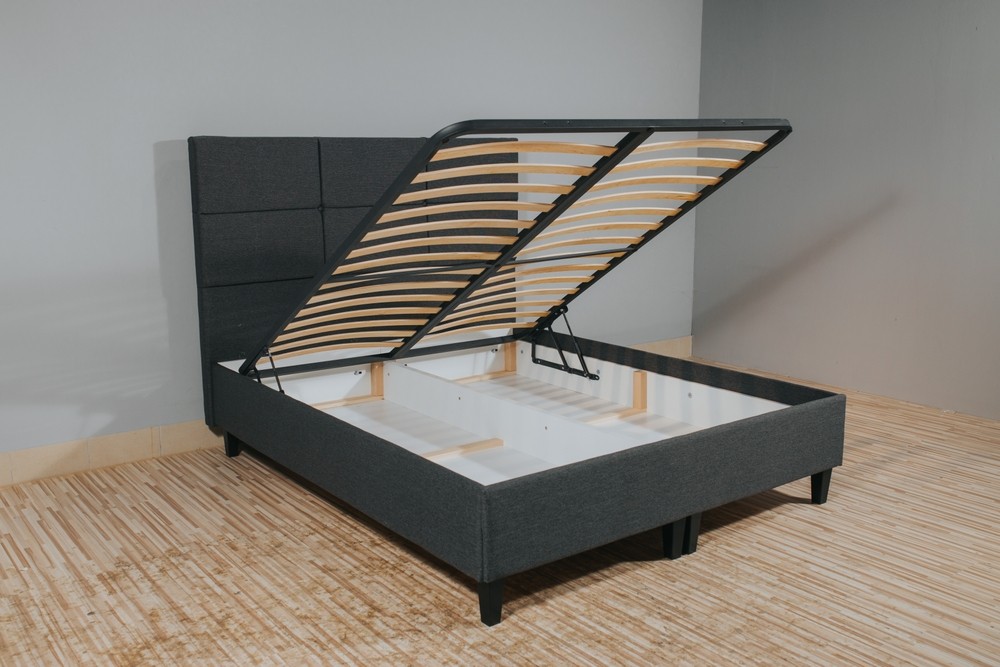What good is a bed frame if it looks great but breaks apart within a year? The reality of reviews only are that many times, people will review a product when they first get them, or after a week, but people rarely remember to go back after a few months or a year to update their review if something breaks down, so that’s why it’s important to be extra careful when buying bed frames online purely based on reviews alone.
Key Components of a Strong Bed Frame
The strength and durability of a bed frame largely depend on several fundamental features. The frame’s design, the materials used, and the quality of workmanship are all crucial.
– Design Features: The architectural design of a bed frame heavily influences its strength. Look for frames with additional center supports and thicker side rails, as they distribute weight more evenly. Platform beds and those with slatted bases with their supporting beams are generally stronger and more durable.
– Material Choice: Different materials offer varying levels of durability and strength. Metal, hardwood, and engineered wood are commonly used, each with its unique benefits.
– Construction and Joints: The method of construction significantly affects durability. Look for frames with solid, reinforced joints and high-quality fastenings. Avoid frames that rely solely on glue, as metal fasteners generally outlast adhesive options.
Each of these aspects plays a critical role in deciding the overall value of the bed frame.
The Role of Materials in Durability
The choice of material is arguably the most important factor when it comes to determining the strength and longevity of a bed frame. Let’s explore some popular materials:
- Metal: Metal frames, often made of steel or iron, are synonymous with durability. They are highly resistant to warping and damage, making them ideal for long-term use. Metal frames can bear a lot of weight and are less likely to develop squeaks over time as compared to wood.
- Solid Wood: Hardwood, such as oak, walnut, or maple, is another strong option. These types of wood are dense and heavy, providing a stable foundation. They have a natural aesthetic appeal and, when properly cared for, can last for generations.
- Engineered Wood: Engineered wood, such as plywood or MDF, made from wood fibers and particles bonded together, is also used for making bed frames. Although generally more affordable than solid wood frames, their durability can match when high-quality materials and craftsmanship are involved.
- Upholstered Frames: These frames use fabric wrapped around wood or metal. The durability here depends on the underlying structure rather than the upholstery itself. They provide a more plush, versatile aesthetic but require frequent maintenance to avoid wear and tear.
Impact of Design on Durability
The design of a bed frame can drastically influence its strength. Beds designed to support heavier weights often have enhanced features like thicker beams and additional leg supports.
– Platform Beds: These have a flat, sturdy surface supporting the mattress, eliminating the need for a box spring. Generally, platform beds are low to the ground, offering significant stability and reducing the risk of tipping.
– Slatted Frames: Slatted beds come with either fixed or adjustable slats. The closer the slats are to each other, the better they are at providing support. They allow for breathability, prolonging mattress life as well.
– Four Poster and Canopy Beds: Traditionally made from solid wood, these frames are known for their robust construction. The prominent corner posts add to the sturdiness while offering a classic aesthetic.
– Adjustable Beds: They offer flexibility in terms of elevation but need robust mechanical features to ensure longevity. It’s important to opt for a reputable brand that uses high-quality materials.
Choosing the right design not only impacts the aesthetic of your bedroom but also contributes significantly to the frame’s durability and your comfort.
Other Factors Contributing to Durability
While material and design are important, other factors also contribute significantly to the durability of a bed frame.
– Quality of Craftsmanship: High-quality craftsmanship can make a substantial difference. This includes attention to detail in joint construction, finishes that protect against environmental damage, and precision in assembly.
– Manufacturer Reputation: Brands with a longstanding reputation for quality are usually more reliable. Researching customer reviews and the brand’s history can provide insight into the reliability of their products.
– Warranty Coverage: A solid warranty can indicate the confidence a manufacturer has in their product. It also offers peace of mind that, should there be any issues, they can be resolved without significant additional expense.
Maintenance Tips for Prolonged Durability
To ensure the longevity of your strong bed frame, regular maintenance is essential. Here are some practical tips to extend the life of your bed frame:
- Regular Inspection: Periodically check the joints and fastenings to ensure they’re secure. If you notice any wobbling or noise, it might be time to tighten bolts or consider reinforcing weak joints.
- Proper Weight Distribution: Avoid exceeding weight limits recommended by manufacturers. Uneven weight distribution can strain certain parts of the frame, leading to damage.
- Environmental Considerations: Keep the room environment conducive to maintaining your bed frame. For wooden frames, avoid excess moisture or extremely dry conditions to prevent warping and cracking.
- Cleaning: Dust and clean the frame regularly using appropriate cleaners. For upholstered frames, vacuuming and occasional spot cleaning can prevent dust buildup and stains.
- Reinforcement: Adding extra supports or slats can help if you notice sagging over time. Consult with the manufacturer for compatible additions.
By incorporating these maintenance practices, you can significantly prolong the life and durability of your bed frame.
The Balance Between Aesthetics and Functionality
While strength and durability are paramount, many wish to maintain aesthetic appeal. The ideal bed frame should marry these two aspects seamlessly:
– Minimalist Designs: Often leverage metal or mixed materials to create sleek, strong structures without sacrificing style. Such designs are particularly popular in modern decor.
– Rustic Appeal: Solid wood frames offer a timeless charm, lending warmth and character to bedrooms. They balance durability with a classic aesthetic.
– Customizable Options: Some frames offer modular designs, where components can be interchanged or added as required, without affecting the strength and durability of the core structure.
Selecting a bed frame involves a careful evaluation of both aesthetics and functionality. Prioritizing one doesn’t mean sacrificing the other when you choose wisely.
Choosing a bed frame built for strength and durability involves more than simply selecting a piece that looks good or comes at the right price. It’s an investment in materials, design, and craftsmanship that will support restful sleep for years. By understanding the critical components that contribute to the strength and durability of bed frames—including material selection, design considerations, and maintenance practices—you can ensure that your bed remains stable, comfortable, and attractive for as long as you need it.



